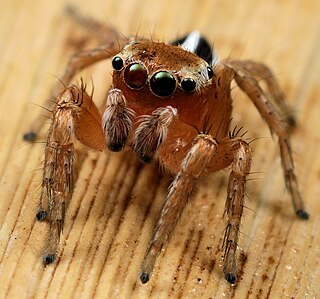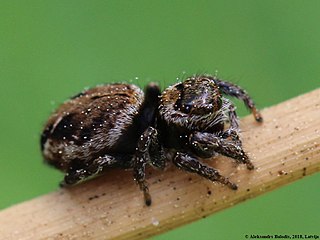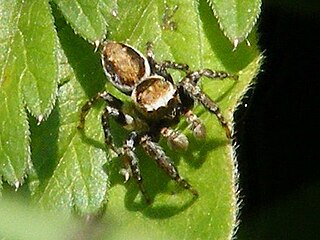Nigorella hirsuta is a species of jumping spider in the genus Nigorella that lives in South Africa and Zimbabwe. It was first describedin 2009 by Wanda Wesołowska. The spider is medium-sized, with a carapace that is between 3.5 and 4.7 mm long and an abdomen that is between 3.2 and 6.6 mm long. The female is larger than the male. The carapace is generally dark brown and hairy. While the male abdomen is similarly hairy and dark brown, the female abdomen is more grey. The species has been confused with the related Nigorella plebeja. However, it can be generally identified by the strongly sclerotized cups in the female epigyne and the male's longer embolus.
Nigorella aethiopica is the type species of the genus Nigorella. A jumping spider that lives in Ethiopia and named in honour of the country in which it is found, it was first described in 2008 by Wanda Wesołowska and Beata Tomasiewicz. The spider is larger than others in the species with a cephalothorax that is between 4.1 and 4.8 mm long and an abdomen that is between 4.3 and 5.6 mm long. The carapace is generally brown and hairy, although the male is darker. While the male abdomen is marked by a light stripe on the topside and dots underneath, the female abdomen has a pattern of a light stripe and patches on the top and dark stripes on the bottom. As well as the larger size, there is a split at the end of the appendage on the pedipalp tibia that marks out the male, and the female has longer seminal ducts and thinner spermathecae than others in the genus.

Evarcha vittula is a species of jumping spider in the genus Evarcha that lives in South Africa. The species was first described in 2011 by Charles Haddad and Wanda Wesołowska. The spider is small, with a carapace measuring between 2.4 and 3.2 mm long and an abdomen between 2.5 and 3.6 mm long. There is a delicate scutum on the abdomen. The spider is generally dark brown but there is an orange streak down the middle of the upper surface of both the abdomen and carapace. This streak helps distinguish the spider from others in the genus. It can also be identified by its copulatory organs. The male has a characteristic short straight embolus. The female has not been described.

Evarcha brinki is a species of jumping spider in the genus Evarcha that lives in Northern Cape, South Africa. The species was first described in 2011 by Charles Haddad and Wanda Wesołowska. The spider is small, with a carapace measuring typically 2.5 mm (0.10 in) long and an abdomen 2.1 mm (0.08 in) long. It is generally yellow, with an orange tinge to the top of the carapace and a darker, nearly black eye field. There are large black spots on the abdomen. While the majority of the legs are yellow, the front pair are brown. It is very different to other African Evarcha spiders. Its copulatory organs are distinctive, particularly the male's embolus, which is short and encircled by a very thin appendage. The female has not been described.

Evarcha acuta is a species of jumping spider in the genus Evarcha that lives in Namibia, Seychelles and South Africa. The species was first described in 2006 by Wanda Wesołowska. The spider is small, with a carapace measuring typically 1.6 mm (0.06 in) long and an abdomen between 1.4 and 1.9 mm long. The carapace is light brown with a short black eye field. The abdomen has patterns that vary depending on geography. The holotype, found near Brandberg Mountain in Namibia, has lines of brown patches on the top. Examples found in Free State, South Africa, have black lines on the top and sides. The spider can be most easily distinguished from other spiders in the genus by its copulatory organs. The male has a distinctive notch on a long straight projection from its tibia known as a tibial apophysis and a long embolus. The female has not been described.

Afraflacilla roberti is a species of jumping spider in the genus Afraflacilla that is found in Kenya. The spider was first defined in 2011 by Wanda Wesołowska. She originally placed the species in the genus Pseudicius, but Jerzy Prószyński moved it in 2017 to Afraflacilla on the basis of shape of its copulatory organs. The species is named after Robert Jackson, the collector who found the first example. The spider is small, with a cephalothorax between 1.7 and 1.6 mm long and an abdomen between 1.7 and 2.4 mm long. The female is larger than the male. The carapace is a dark brown elongated oval with a black eye field covered in white hairs. The abdomen is blackish-brown and is marked by two pairs of white patches and a small number of faint chevrons at the very rear. Some female examples have a generally featureless dark abdomen and others have additional small rounded patches at the edge. Some have light stripes to the front of the abdomen. The spider has yellow legs, apart from the front pair, which are brown, longer and stouter. It stridulates using its legs and carapace. Afraflacilla roberti can be differentiated from other species in the genus by its copulatory organs. The male has a long thin tibial apophysis. The female has narrow coiled insemination ducts.

Evarcha mirabilis is a species of jumping spider in the genus Evarcha that ilives in Kenya and South Africa. The species was first described in 2009 by Wanda Wesołowska and Charles Haddad. The spider is small, with a dark brown carapace measuring typically 1.9 mm (0.07 in) long and a russet-brown abdomen that is typically 1.7 mm (0.07 in) long. It is similar to related species in the genus, particularly Evarcha maculata and Evarcha patagiata. The spider has a yellow pattern on the top of its abdomen, its underside being a uniform yellow, while the underside of the carapace is orange. The legs individually have a pattern of yellow, black, yellow. The pedipalps are similarly yellow and black. The male can be distinguished from others in the genus by its copulatory organs, particularly the shape of the projection from its palpal tibia or tibial apophysis, which is short and sharp and connected to the tibia through a large base. The female has yet to be described.

Aelurillus timidulus is a species of jumping spider in the genus Aelurillus that is endemic to Ethiopia. It was first described in 2008 by Wanda Wesołowska and Beata Tomasiewicz. Only the female has been described. It is a small spider with a cephalothorax 2 mm (0.079 in) long and rounded abdomen 2.8 mm (0.11 in) long. The body is black at the front, dark brown at the back of the high pear-shaped carapace and greyish beige across the abdomen. It has a smaller epigyne than others in the genus, but the copulatory organs are otherwise similar to other Aelurillus spiders, having a central pocket and wings alongside the copulatory openings.

Evarcha aposto is a species of jumping spider in the genus Evarcha that lives in Ethiopia and Nigeria. The species was first described in 2008 by Wanda Wesołowska and Beata Tomasiewicz. It is named for the place in Ethiopia where is was first found. The spider is small, with a cephalothorax measuring between 1.9 and 2.2 mm long and an abdomen between 1.8 and 1.9 mm long. The carapace is generally light, yellow or fawn, with a dark stripe down the middle and occasionally a thin stripe to the rear. The abdomen is yellow with a pattern of darker patches. It has a black eye field. The front legs are darker, brown in the case of those found in Nigeria and black for the Ethiopian examples. The remaining legs have a distinctive top half that is black or brown, the remainder being yellow. Its copulatory organs are distinctive, particularly the male's very short embolus, which is accompanied by a spoon-like appendage. The female has not been described.

Evarcha awashi is a species of jumping spider in the genus Evarcha that lives in Ethiopia. The species was first described in 2008 by Wanda Wesołowska and Beata Tomasiewicz. The spider is small, with a cephalothorax measuring between 2.0 and 2.3 mm long and an abdomen between 1.9 and 2.4 mm long. The male and female are similar in size but differ slightly externally. The male carapace is orange while the female is brown, both with a darker eye field. The pattern on the abdomen is generally similar, a combination of light background and dark patches, but the female has less contrast between the two. The legs are mainly brown with yellowish tarsi. Its copulatory organs are distinctive. The male has a short embolus that follows the palpal bulb and a sharp tooth on its short wide and blunt protrusion on its palpal tibia, or tibial apophysis. The female has insemination ducts that narrow into multi-chambered spermathecae.

Evarcha pinguis is a species of jumping spider in the genus Evarcha that lives in Ethiopia. The species was first described in 2008 by Wanda Wesołowska and Beata Tomasiewicz. The spider is larger than others in the genus, with a cephalothorax measuring 3.4 mm (0.13 in) long and an abdomen between 4.7 mm (0.19 in) long. The spider is dark brown and hairy apart from a lighter streak on the back of the carapace and a pattern of light chevrons down the back of the abdomen. The legs are brown, the front four being thicker and shorter than the rest. The copulatory organs are distinctive. The female has marked sclerotization to the edge of its epigyne. The male has not been described.

Evarcha rotundibulbis is a species of jumping spider in the genus Evarcha that lives in Ethiopia. The species was first described in 2008 by Wanda Wesołowska and Beata Tomasiewicz. The spider is small to medium-sized, with a cephalothorax measuring between 2.4 and 2.7 mm long and an abdomen between 2.3 and 2.6 mm long. The carapace is light brown with a dark brown eye field. The abdomen is russet with a yellowish pattern of arrows and spots. The spider has brown and yellow legs. Its copulatory organs are unusual and help identify it. The male has a distinctive rounded palpal bulb that is recalled in the name of the species. It also has a very short forked embolus and a shovel-like projection, or apophysis, on the palpal tibia that distinguishes it from other related species. The female has not been described.

Evarcha russellsmithi is a species of jumping spider in the genus Evarcha that lives in Ethiopia. The species was first described in 2008 by Wanda Wesołowska and Beata Tomasiewicz. The spider is small to medium-sized, with a cephalothorax measuring typically 2.2 mm (0.09 in) long and an abdomen 1.8 mm (0.07 in) long. The carapace is yellowish with dark rings around the spider's eyes. The abdomen is brown with an indistinct pattern of spots and lines. The legs are generally brown. The copulatory organs are distinctive. The male has a projection, or apophysis, from the palpal tibia that is has a series of tooth-like features, and a very short embolus that is attached to another very small apophysis. The female has multi-chambered spermathecae and distinctive accessory glands.

Pseudicius ridicularis is a species of jumping spider in the genus Pseudicius that lives in Ethiopia. The spider was first described in 2008 by Wanda Wesołowska and Beata Tomasiewicz. The spider is medium-sized, with a cephalothorax that is between 2.1 and 2.2 mm long and an abdomen that measures between 2.6 and 3.1 mm long. It has a dark brownish carapace, while the abdomen differs between the male, which has a yellowish-brown hue, and the female, which is marked by an indistinctive pattern of brown patches. It is the copulatory organs that most enable the spider to be distinguished. The male has a particularly large bent tibial apophysis and a short thick embolus. The female has longer spermathecae than others in the genus.

Evarcha bakorensis is a species of jumping spider in the genus Evarcha that lives in Guinea, Ivory Coast and Nigeria. It thrives in savanna grasslands. The species was first described in 2002 by Christine Rollard and Wanda Wesołowska. The spider is small, with a cephalothorax measuring between 1.6 and 1.8 mm long and an abdomen that is between 1.3 and 1.9 mm long. The female is larger than the male. The cephalothorax has a light brown topside, or carapace, yellow underside, or sternum, and darker sides. The abdomen is greyish-brown or brown and has a lighter pattern on it. The spider has generally brown legs. It has distinctive copulatory organs. The female has a large membrane in the centre of its epigyne while the male has a straight and blunt tibial apophysis, or projection on its palpal tibia.

Evarcha certa is a species of jumping spider in the genus Evarcha that ilives in Guinea and Ethiopia. It thrives in grasslands, particularly near bodies of water like the Baro River and in areas of high altitude such as the Guinea Highlands. The species was first described in 2002 by Christine Rollard and Wanda Wesołowska. The spider is small, with a cephalothorax measuring between 2.6 and 2.9 mm long and an abdomen that is between 2.7 and 3.4 mm long. The cephalothorax has a reddish-brown topside, or carapace, with a darker eye field, and an orange underside, or sternum. The abdomen has a pattern consisting of irregular brown patches, although this differs between individual spiders. The spider has orange or yellow legs. It has distinctive copulatory organs. The female has relatively simple spermathecae that are heavily sclerotized and short insemination ducts. The male has not been described.

Evarcha idanrensis is a species of jumping spider in the genus Evarcha that lives in Nigeria. It is named after Idanre Hill in Ondo State, where it was first found. The species was first described in 2011 by Wanda Wesołowska and Anthony Russell-Smith. The spider is hard to distinguish from other spiders in the genus. It has a cephalothorax measuring between 2.1 and 2.5 mm long and an abdomen between 2.2 and 3.5 mm long. It has a yellow carapace with a black eye field and light brown legs. The abdomen is brownish-grey with an indistinct pattern on its back. Apart from the size of the epigyne, the female's copulatory organs are similar to other members of the genus. The male has not been described.

Hyllus nigeriensis is a species of jumping spider in the genus Hyllus that is endemic to Nigeria. It lives in rainforest. The spider was first described in 2012 by Wanda Wesołowska and G. B. Edwards. A medium-sized spider, it typically has a cephalothorax 4.1 mm (0.16 in) long and an abdomen 4.0 mm (0.16 in) long. The abdomen is reddish-brown and narrower than the light brown carapace. Originally tentatively allocated to the genus Brancus, the species was allocated to Hyllus in 2022. Only the female has been described.
Hasarinella distincta is a species of jumping spider in the genus Hasarinella that lives in South Africa. The species was first described in 2013 by Charles R. Haddad and Wanda Wesołowska. With a dark brown oval cephalothorax] that is between 3.4 and 3.8 mm long and a brown ovoid abdomen that has a length between 3.7 and 4.5 mm. The male has a marking of three white streaks, one in the middle and two along the edges, on the carapace. The female does not. It is the copulatory organs that enable the species to be differentiated from the related Hasarinella berlandi, particularly the wider seminal ducts in the female and the oval palpal bulb in the male. It lives in both grassland and woodland.

Plexippus baro is a species of jumping spider in the genus Plexippus that lives in the Ethiopia. The male was first described by Wanda Wesołowska and Beata Tomasiewicz in 2008. The female has not been identified. The spider is medium-sized with a cephalothorax that is typically 2.7 mm (0.11 in) long and an abdomen 3.6 mm (0.14 in) long. The carapace is brown with three white stripes and the abdomen is russet-brown with a single white stripe. The spider has a pattern of two narrow white stripes on its clypeus which give it a distinctive face. The copulatory organs distinguish it from related species, particularly the male's longer embolus.
















